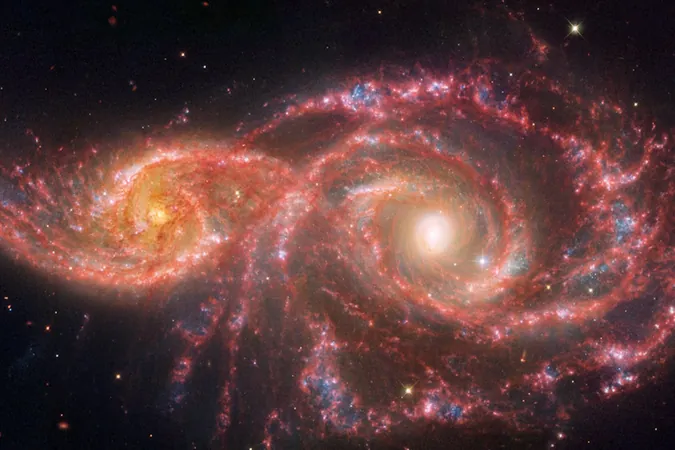
Unveiling the Cosmic Horror: Hubble and Webb Capture Galaxies Glaring at Earth
2024-10-31
Author: Arjun
Introduction
In a startling collaboration, NASA’s Hubble and Webb space telescopes have unveiled a mesmerizing yet terrifying image of two spiral galaxies poised for a catastrophic collision—a celestial drama that could last millions of years. This striking image appears like a pair of ominous, blood-soaked eyes glaring at Earth from the dark expanse of space, giving rise to a tale of cosmic horror.
The Galaxies in Focus
The newly crafted image reveals the galaxies IC 2163 and NGC 2207, with the smaller IC 2163 lurking behind its larger counterpart, NGC 2207. The blood-like coloring of the image comes from a unique blend of mid-infrared light captured by Webb, combined with visible and ultraviolet light from Hubble. The vivid, red veiny streaks are indicative of material ejected during their initial close encounter, marking the beginning of their gradual merger—a celestial event predicted to unfold over eons.
Star Formation and Activity
These spiral galaxies are not just marked for impending doom; they are also bustling with new star formation at an impressive rate. Together, they produce an astonishing two dozen new stars resembling our Sun each year, dwarfed in comparison to the Milky Way, which generates merely two or three. Within recent decades, both galaxies have sparked seven known supernovae, contrasted sharply with the Milky Way’s solitary supernova every 50 years. This heightened activity hints at a dynamic environment where dust and gas clear out, creating fertile grounds for the birth of new stars.
Vivid Cosmic Imagery
In this exhilarating image, star-forming regions burst forth in vibrant hues; bright blue highlights signify intense ultraviolet activity recorded by Hubble, while Webb’s mid-infrared capture reveals fainter pink and white tones. These galactic hotspots contain mini starbursts, regions where stars are rapidly born en masse, painting an energetic picture of stellar life cycles.
The Cosmic Dance
As these two mighty galaxies continue their cosmic dance, they will repeatedly draw near to one another, altering their shapes in the process. Over the course of their merger, the two distinct spiral structures will blend into an odd-shaped formation reminiscent of the Eye of Sauron, shifting from a pair of sinister gazes into a single, sprawling entity staring into the void.
Other Celestial Observations
While the universe has captured the imagination with this engaging cosmic tale, other peculiar celestial occurrences have also been observed. The European Southern Observatory (ESO) has recently taken a stunning image of a dark nebula, nicknamed the Dark Wolf Nebula, located approximately 5,300 light-years away in the constellation Scorpius. This nebula, shrouded in cosmic dust, obscures the light of distant stars, creating an eerie silhouette reminiscent of a wolf—or perhaps a horse—floating ominously in space.
A Whimsical Martian Sight
Adding a lighter touch to recent astronomical phenomena, NASA's Perseverance rover caught an amusing sight on Mars: the potato-shaped moon Phobos passed directly in front of the Sun, casting a shadow that resembled a googly eye staring down at the rover. Although less intimidating than the cannibalistic galaxies or the enigmatic Dark Wolf Nebula, this Martian jest adds a whimsical element to our exploration of the universe.
Conclusion
As we gaze into the cosmos, it's clear that the skies are filled with both chilling and humorous spectacles. The universe remains a vast, unpredictable playground of wonders waiting to be unraveled!




 Brasil (PT)
Brasil (PT)
 Canada (EN)
Canada (EN)
 Chile (ES)
Chile (ES)
 España (ES)
España (ES)
 France (FR)
France (FR)
 Hong Kong (EN)
Hong Kong (EN)
 Italia (IT)
Italia (IT)
 日本 (JA)
日本 (JA)
 Magyarország (HU)
Magyarország (HU)
 Norge (NO)
Norge (NO)
 Polska (PL)
Polska (PL)
 Schweiz (DE)
Schweiz (DE)
 Singapore (EN)
Singapore (EN)
 Sverige (SV)
Sverige (SV)
 Suomi (FI)
Suomi (FI)
 Türkiye (TR)
Türkiye (TR)